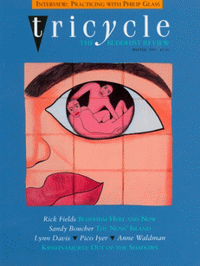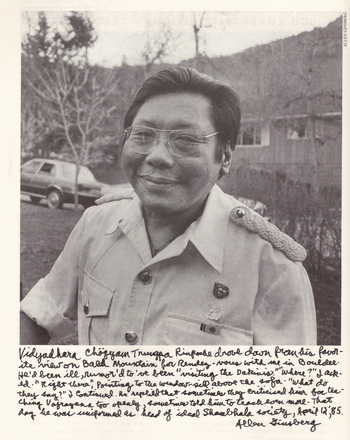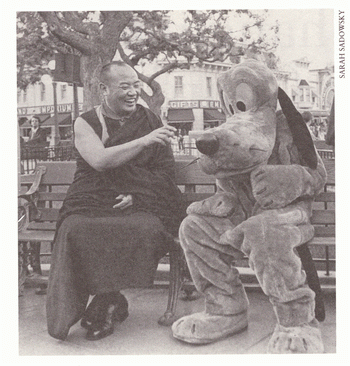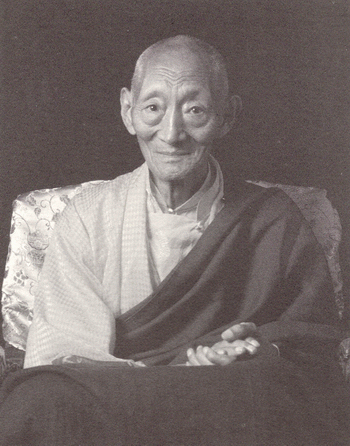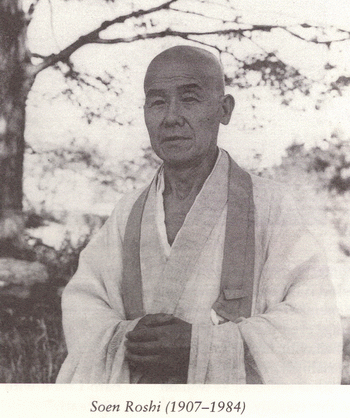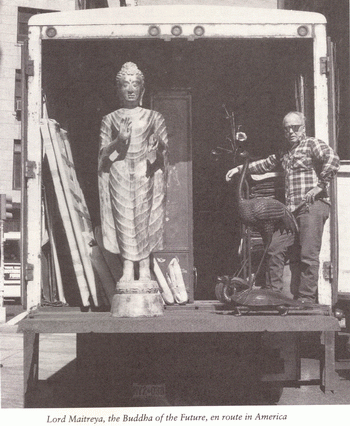The Changing of the Guard WESTERN BUDDHISM IN THE
EIGHTIES RICK FIELDS Rick Fields is the author of How
the Swans Came to the Lake: A Narrative History of Buddhism
in America (Shambhala Publications, 1981) and the former
editor of The Vajradhatu Sun. His latest book is Code o f
the Warrior (Harper Collins, 1991). THE
PROCESSION carrying the body of Chogyam Trungpa Rinpoche was
heralded by the wails of a lone bagpiper and the slow,
steady heartbeat of a deep bass drum, followed by the hoarse
guttural cries of Tibetan horns. As a crowd of more than
three thousand American students and guests watched in
silence, the funeral procession of Trungpa Rinpoche emerged
from a fogbound forest at the Karme Choling retreat center
in northeast Vermont. The body was carried in a palanquin-a
canopied, silk-curtained upright box-and covered with a
round white parasol. The palanquin was then lifted into the
ornately painted cremation stupa, twenty-five feet high and
surmounted with a gold spire. This cremation puja was performed by
Tibetan monks led by three of the four regents of the Kagyu
school, as well as the late Dilgo Khyentse Rinpoche, one of
Trungpa Rinpoche’s teachers and the head of the Nyingma
school. This much was traditional. There were, however, a
number of innovations, befitting the cremation of a teacher
who had done so much to bring Buddhism, particularly the
Tibetan Vajrayana (Diamond Vehicle) into a new country and
time. To begin with, the fire puja was also performed by a
contingent of American Buddhists. These practitioners
performed the same liturgy as the Tibetan monks and lamas,
making the same fluid mudras (ritual gestures) with bell and
vajra, albeit a bit less gracefully, and they attempted the
same visualizations and formless meditations. The Americans,
however, chanted the liturgy in an English version. Further,
the American tantrikas were nearly all lay persons who had
found time to complete the difficult and time-consuming
preliminary practices of Tibetan Buddhism while holding down
jobs and raising families. They were also evenly divided
between men and women. Thus, although everything had been
done according to ancient tradition, there were certain
changes-changes that were more or less assumed to be natural
and necessary to both Tibetan mentors and their American
students. His Holiness Gyalwa Karmapa
(1923-1981) – On a visit to Disneyland TRUNGPA
RINPOCHE had died on April 4, 1987, at the age of 47, in
Halifax, Nova Scotia, where he had moved the international
headquarters of the Vajradhatu Buddhist Church. Officially
it was said that he had died from cardiac arrest and
respiratory failure. That was technically correct, but many
people, including some of his most devoted students, thought
that his death was related to, if not caused by, his
legendary drinking. From the traditional Tibetan point of
view, however, Trungpa Rinpoche was not an ordinary man but
a bodhisattva, an enlightened master who had vowed to take
rebirth in order to liberate all sentient beings. Because of
this, all his actions, no matter how problematic they may
have looked from a conventional point of view, were to be
taken as selfless teachings. Trungpa himself seemed to have
little doubt about either the timing or meaning of his
death. “Birth and death are expressions of life,” he wrote
in a message read after his death. “I have fulfilled my work
and conducted my duties as much as the situation allowed,
and now I h a v e passed away quite happily…. On the
whole, discipline and practice are essential, whether I am
there or not. Whether you are young or old, you should learn
the lesson of impermanence from my death.” THE DEATH OF CHOGYAM TRUNGPA
RINPOCHE did indeed underscore the truth of impermanence.
Another era in the history of American Buddhism had come to
an end with the passing of many of the first generation of
teachers who had been trained in Asia. Trungpa Rinpoche had
been preceded by Shunryu Suzuki Roshi, the founder of the
San Francisco Zen Center, in December 1971; Haku’un Yasutani
Roshi and Nakagawa Soen Roshi, who died respectively in 1973
and 1984, had lived long enough to witness the seeds of
their Japanese Zen lineages cultivated from New York to
Hawaii. His Holiness the Gyalwa Karmapa, head of the Kagyu
school, passed away in Chicago in 1981; in 1984, Lama
Thubten Yeshe left his center in Kopan, Nepal, to die among
his many Western disciples at Vajrapani Center, in Boulder
Creek, California, where he was cremated according to
tradition. IN 1987 – the year of Trungpa
Rinpoche’s death-His Holiness Dudjom Rinpoche, head of the
Nyingma School and a terton, or revealer of hidden
teachings, died at the age of 82 at his center in Dordogne,
France. That same year Deshung Rinpoche, the Sakya lama who
had come to Seattle twenty years before, died in Nepal. Two
years later, Kalu Rinpoche, the modern Milarepa, died at his
monastery in Sonbada, India, at the age of 84. During his
four tours of North America, he taught the dharma, as he
said, “in a traditional way, without combining it with any
other viewpoints,” and he trained many Western lamas in the
full three year retreat. Finally, on March 1, 1990, Dainin
Katagiri Roshi died at the Minnesota Zen Temple in
Minneapolis. He had come to assist at the Soto Zen
Headquarters in Los Angeles in 1963 and had then worked
closely with Sunryu Suzuki Roshi in San Francisco. Then,
three months before his death, he had performed the
ceremonies marking the completion of training for twelve Zen
priests, just one Japanese, and eleven Americans. Because so many of these
early great pioneers had left behind American teachers, it
was easy to think that American Buddhism had finally come of
age. But it soon began to seem that it had entered a period
of adolescence – an awkward, aggressive adolescence marked
by acute growing pains. A number of teachers, American
dharma heirs as well as their Asian teachers, fell into a
very American trap, namely the abuse of power particularly
in sexual and financial areas; moreover, they found the
details of their personal lives subject to an equally
American scrutiny and outrage. To many American Buddhists,
both students and teachers, it seemed that the meeting of
East and West heralded by the heady Sixties and early
Seventies had turned into nothing less that a head-on
collision. Signs of trouble first appeared
publicly in 1983 at the San Francisco Zen Center, long
thought of as the very model of a modern Zen center. Under
the guidance of Suzuki Roshi’s dharma heir, Richard Baker
Roshi, Zen Center had grown enormously, both in size and
influence. Zen Center consisted of three major centers: Page
Street, a residential center in San Francisco; Green Gulch,
an idyllic farm and lay center nestled in a valley next to
Muir Beach on the slopes of Mount Tamalpais; and Tassajara,
the mountain retreat center. The community businesses, which
included the Green Gulch Grocery, the Tassajara Bakery,
Alaya Stitchery, and Green’s, a highly successful gourmet
vegetarian restaurant overlooking San Francisco Bay, were
all staffed by Zen students, many of whom also lived in
either Page Street or Green Gulch. The initial spark that set
off what would soon become a raging conflagration was the
revelation that Baker Roshi had been having an affair with a
married woman student. This turned out to be the proverbial
straw. In the meetings that followed, a number of people
revealed other “secret” affairs. In addition, there were
also charges of financial improprieties, or at the very
least, inappropriateness, relating to Baker Roshi’s three
residences (in San Francisco, Tassajara, and Green Gulch
Farm), his mode of transportation (a white BMW), his
extensive library (in triplicate, one at each residence),
his art collection, and so on. It was also said that he was
using his office to further his own ambitions – that he
spent too much time with friends such as Governor Jerry
Brown, Esalon director Michael Murphy, and Whole Earth
publisher, Stuart Brand, that he had neglected both his own
practice and his teaching responsibilities. In short, he
lived far too fast and well, while longtime students
languished in low-paying jobs that were supposed to be “good
for their practice.” A SERIES OF MEETINGS and
confrontations followed, but clear communications seemed to
elude both the Zen master and the students who had spent
fifteen or twenty years practicing to gain clarity of mind.
In the end, Baker Roshi left for Santa Fe, and then
Crestone, Colorado, where he began teaching a few old and
some new students under the auspices of the Dharma
Sangha. Much discussion centered on the
faults of Baker Roshi as well as on “the conspiracy of
silence” that had allowed many senior students to say
nothing even when so much was amiss. But it also became
clear that part of the problem had been caused by a
characteristically American institution, “the Zen center.”
Suzuki Roshi had once remarked that Americans were not quite
monks nor lay people but something in between. His own
center, like most other residential Zen centers in the
United States, had tried to find a way to integrate the
intensity of monastic practice with an American community
open to both men and women. Though many of the most serious
practitioners were ordained as priests, shaving their heads
and wearing robes, they were not celibate, and so as the Zen
center grew and matured, so did their families. In Japan, Zen priests typically
marry and take on the job of running a temple after a three
– or four-year course of training in a monastery. In
America, however, training seemed to go on forever, and
after ten or fifteen years it was hardly surprising that
many priests and residents came to think of the Zen center
as their home and community. There were, in any case, few if
any affiliated temples for priests to minister. What, then,
did a Zen priest who had lived in a Zen center for ten or
fifteen years training and studying do when he or she
realized that even enlightenment wasn’t going to solve
everything? For some, it now began to seem that they had
paid a rather high price for their youthful idealism. They
had learned how to sit zazen; they had the security of
community; but they had neglected careers and professions.
They had not learned how to make their way in the world.
They had not grown up. SAN FRANCISCO ZEN CENTER
MEMBERS turned, for the moment, to professional
“facilitators.” Communications experts and psychologists
were invited to give workshops. Some found disturbing but
illuminating parallels between Buddhist centers and
alcoholic or other dysfunctional families, in which – as one
Zen Center member put it – “we’ve learned all too well how
to keep silent and how to keep secrets.” In response, ways
were sought to make Zen Center more open and democratic. New
board members were elected instead of being appointed; and
in the biggest departure from tradition, the new abbott, Reb
Anderson, was hired for a four-year term. Nearly ten years later, Norman
Fischer, a Zen priest who now teaches and lives at Green
Gulch, reflected on the turmoil. “Teacher-student
relationships come out of the fabric of the society that
produced them,” Fischer explained in the Buddhist Peace
Fellowship Newsletter. “The Roshi comes out of the
Sino-Japanese Confucian tradition of ancestor worship. Put
that beautiful Roshi in the middle of our Freudian
Oedipal-will-to-power tradition, and it is little wonder
that people are going to be confused for a hundred years or
so.” Before long, the problems at the San
Francisco Zen Center began to seem less of an isolated
incident than part of a pervasive pattern. In the next few
years a rather large number of Zen teachers found themselves
in a similar compromised Dudjom Rinpoche (1904-1987)
position. Taizan Maezumi Roshi of the Zen Center in Los
Angeles admitted to an affair with a senior student, which
led to concern about his drinking, and he entered an alcohol
treatment center. Seung Sunim, the supposedly celibate
Korean Zen master, revealed a long-term relationship with
two students. An elderly, supposedly celibate teacher
visiting the Insight Meditation Society in Barre,
Massachusetts, was confronted after he made advances to a
female student. As “the conspiracy of silence” was
broken, more and more women came forward to reveal problems
with a number of other teachers, some of whom denied the
accusations or simply remained silent. In 1985, Jack
Kornfield published the results of a survey he had made on
the “Sex Lives of the Gurus” in Yoga Journal. Kornfield, a
highly respected teacher of the Theravada vipassana
tradition and the holder of a doctorate in clinical
psychology, noted that out of the fifty-four Buddhist,
Hindu, and Jain teachers he had interviewed, thirty-four had
had sexual relationships of one kind or another with a
student. Half of these students reported that they felt that
the relationship with their teacher had “undermined their
practice and their feelings of self-worth.” The most shocking news within the
Western Buddhist community at large came three years ago
when members of the board of directors of Vajradhatu, one of
the largest Tibetan communities in North America, instructed
teachers in local centers to inform the community that Osel
Tendzin, the American regent appointed by Trungpa Rinpoche,
had AIDS, had not informed his sexual partners, and that
anyone who might be at risk should be tested. “Since none of
us believes the Vidyadhara taught magical protection’
against natural cause and effect,” as one board member later
put it, “this seemed like a necessary minimal step to take
to protect people’s health.” As it turned out, one of the
regent’s partners, a young man in his twenties, apparently did contract
the virus from him and then inadvertently passed it on to a
girlfriend. It was also said that some members of the
regent’s inner circle had said nothing, even though they had
been aware of the regent’s behavior for some
time. Many people, not surprisingly,
reacted with a sense of outraged betrayal. Some reflected as
well on the part they had played in this tragedy. “The Vidyadhara made it clear to his
closest students that the regent is not a fully realized
person and that it is our responsibility to be clearly
critical of him,” one senior student wrote in a letter that
was widely circulated. “The recent events have made it clear
to us that over the years we have not fulfilled this
responsibility. This, our own ignorance and laziness, has
allowed things to be brought to a painful point.” WHEN THE NEWS FIRST BECAME
KNOWN in the Vajradhatu community, the regent’s own
community, I had the opportunity to meet with Osel Tendzin
face-to-face. He was in San Francisco, just having left a
long retreat, and was preparing to speak to the sangha at
the local center in Berkeley. Sitting across from him in a
living room, with four or five other close and concerned
students present, I asked, “So what happened?” His answer
was direct and spontaneous: “I was fooling myself,” he told
me. As we discussed the situation, subsequent Lord Buddha said, there is no fault
so grievous that it cannot be purified.” Many students,
including the board of directors, asked the regent to
withdraw from teaching and the leadership of Vajradhatu. He
refused. “To withdraw,” he said, “would violate the oath I
took with my guru, and it would also violate my
heart.” Kalu Rinpoche (1904-1989) The sangha itself was deeply
divided. There were those who wanted the regent to
resign or be removed by the board of directors. Others
thought that he had expressed sufficient remorse and that it
did no good to blame or “demonize” him. Still others suggested that the
regent’s plight was not unconnected to the risks inherent in
Trungpa Rinpoche’s “crazy wisdom” tradition, which included
outrageous and unconventional behavior as part of its
teaching repertoire. When the board of directors consulted
Tibetan elders in Nepal and India, they suggested a
traditional Tibetan solution: they advised the regent to go
into retreat. For more than a year, continual turmoil
reigned. The regent did take up residence in Ojai,
California, along with his family and a band of loyal
students, but he continued to act as both spiritual and
administrative head of Vajradhatu. Consequently, two
Vajradhatus now existed, one in Halifax, where the board
resided, and one in Ojai. When the regent and the board of
directors blocked the community’s newspaper, The Vajradhatu
Sun, from covering “the current situation,” which by then
had been reported in The New York Times as well as in many
other papers, students published an “independent” journal
called Sangha. In the end, the regent did finish
his days in retreat. On August 26, 1991, the morning after
Osel Tendzin died, Osel Mukpo (Trungpa Rinpoche’s eldest
son) was appointed spiritual leader of Vajradhatu. The
Sawang, as he was called, who was twenty-seven, returned to
India in July of 1991 hoping to gain entry to Tibet in order
to receive the complete cycle of the Surmong teachings at
the monastery his father had left thirty years
before. As painful as it has been, the
unraveling of institutional Buddhism, has resulted in a
valuable reexamination of the place of Buddhist practice in
American society. At the very least, such problems have cut
through romantic projections and thrown American Buddhists
back on their own meditation cushions. During the Eighties it began to look
as if anyone in a position of power clergymen, therapists,
doctors, lawyers, teachers, and politicians-might be tempted
to abuse that power. As Peter Rutter, M.D., writes in Sex in
the Forbidden Zone, “Sexual violation of trust is an
epidemic, mainstream problem that essentially reenacts
within the professional relationship a wider cultural
power-imbalance between men and women.” Viewed within this larger context,
the “fall” of a teacher turns out to be rich in spiritual
lessons. It brings one back to the critical self-awareness
and self-reliance crucial to the teachings of the Buddha,
who said, “Do not believe in anything simply because you
have heard it. Do not believe in traditions because they
have been handed down for many generations. Do not believe
in anything simply because it is found written in your
religious books. Do not believe in anything merely on the
authority of your teachers and elders. But after observation
and analysis, when you find that anything agrees with reason
and is conducive to the good and benefit of all, then accept
it and live up to it.” Zen teacher Yvonne Rand says this
quote should be “tattooed on our eyelids.” Soen Rosh (1907-1984) The general disillusionment
also made practitioners reflect on the difficulties of the
path itself. Every level of spiritual insight seemed to cast
a corresponding shadow. The closer one got to the heart of
the matter, the more furiously the forces of ignorance and
habitual pattern fought b a c k. Shakyamuni, the historical
Buddha, was tempted by both the demons and the daughters o f
Mara just before he broke through to his final, complete
enlightenment. A little bit of enlightenment,
Western Buddhists were finding out, could be a dangerous
thing, especially if it led to a feeling of transcendental
invulnerability. No wonder Bodhidharma had warned: “one who
thinks only that everything is void is ignorant of the law
of causation.” The responsibility for both teachers
and students, then, is not to judge and condemn but to work
on themselves and to help each other dispel the clouds of
ignorance in order to uncover their common, original
enlightenment. Easier said than done, of course. But the
tradition goes all the way back to Shakyamuni. The
Vietnamese teacher Thich Nhat Hanh, one of the most
consistent voices for reconciliation, told the story of the
pirate Angulimala, who believed he would gain all he desired
by stringing a necklace made out of the knuckles of a
hundred hands. When he encountered the Buddha, he was filled
with remorse, but he felt it was too late for him to change
his ways. “It is never too late,” the Buddha replied. “The
ocean of suffering is immense, but as soon as you turn
around, immediately you can see the other shore.” Lord Maitreya, the Buddha of the
Future, en route in America Reflecting
on the problems of American Buddhism in the 1980s, the
Dalai Lama has emphasized that it is important for students
to test their teachers for five, ten, or even fifteen
years. “Part of the blame lies with the
student, because too much obedience, devotion, and blind
acceptance spoils a teacher. Part lies also with the
spiritual master, because he lacks the integrity to be
immune to that kind o f vulnerability.” He recommends never
adopting the attitude toward one’s spiritual master of
seeing his or her every action as divine or noble. “This may
seem a little bit bold, but if one has a teacher who is not
qualified, who is engaging in unsuitable or wrong behavior,
then it is appropriate for the student to criticize that
behavior. “ When a reporter asked him if he had
any observations to make about the future of Buddhism in
America, the Dalai Lama said, “the teaching aspect will
always remain the same because the origin is the same. But
the cultural aspect changes. Now you see Buddhism come West.
Eventually, it will be Western Buddhism. That, I think, is
very helpful – that Buddhism become a part of American
life.” And so it is. American Buddhism is
hammering out its own shape: an emphasis on householder
instead of monk, community instead of monastery, and a
practice that integrates and makes use of all aspects of
life, for all people, women as well as men. But whatever the
shape taken, the shining well-worn gold of the Buddha’s
teaching remains the same: the Four Noble Truths – the fact
of suffering, its origin, cessation, and the path – and the
daily attention that puts it all into practice, again and
again and again.
“The Changing of the Guard,” is
excerpted from the third revised edition of How
the Swans Came to the Lake,
available at Amazon. 